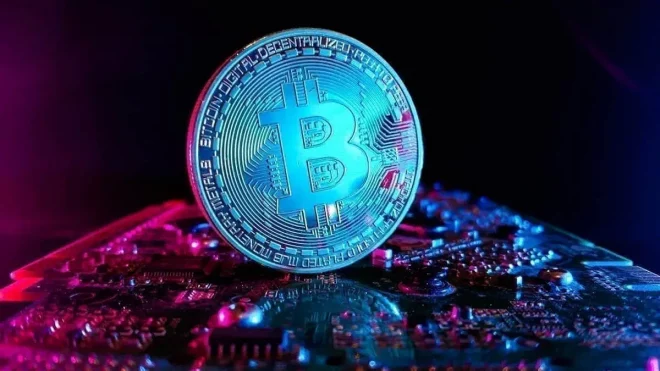
What is bitcoin?
Bitcoin was invented by Satoshi Nakamoto, a pseudonymous person or group that published a white paper in 2008 summarizing the technology. It’s a simple and appealing concept: Bitcoin is a digital currency that allows for safe peer-to-peer Internet transactions.
Bitcoin is decentralized, unlike services like Venmo and PayPal, which rely on the old money financial system and current debit/credit accounts to make transfers. You’ll need a bank, a government agency, or some other type of entity.
The blockchain keeps track of every bitcoin transaction. Blockchain functions similarly to a bank ledger or a ledger of clients entering and exiting a bank. Simply explained, it is a record of all bitcoin transactions that have ever taken place.
The bitcoin blockchain, unlike a banking book, is dispersed over the network. This network is not controlled by any company, country, or third party, and anyone can join it.
There will be just 21 million bitcoins available. It is digital money that is unaffected by inflation or manipulation in any form.
You don’t have to acquire all of the bitcoins; if that’s all you want or need, you can just buy a portion of the coin.
Who Created Bitcoin?
It’s best to start at the beginning if you really want to grasp how Bitcoin works. The subject of who founded Bitcoin is intriguing because, despite the fact that the technology has been scrutinized by journalists and members of the crypto community for over a decade, its originator remains unknown.
Bitcoin’s concepts were initially made public in a white paper published online by a person or group known as Satoshi Nakamoto in late 2008.
This isn’t the first white paper to look into the possibility of employing digital currency in the realm of encryption and computing. Indeed, the post refers to previous ideas, but it was a particularly elegant solution to the problem of establishing trust between different network organizations, where people (such as Bitcoin’s creator) frequently hide behind pseudonyms or physically introduce themselves on the other side of the network.
Nakamoto created two related ideas: the Bitcoin private key and the blockchain ledger. You control your bitcoins with a private key, which is a randomly generated sequence of numbers and letters that unlocks your virtual storage after you purchase them. Each private key is recorded in a blockchain, a distributed ledger.
When Bitcoin originally arrived, it was a huge step forward in computer science because it solved the fundamental problem of online trading: how to send money between two individuals without using a trusted intermediate (like a bank). Bitcoin’s inception has far-reaching repercussions by eliminating this problem: as an Internet currency, it enabled cross-border and global financial transactions without the intervention of banks, credit card companies, lenders, or even governments.
When two people, regardless of where they live, can send each other payments without having to meet these coordinators, a more efficient, free, and innovative open financial system emerges.
Bitcoin’s Operation
Bitcoin is not owned by anybody or any company, unlike credit card networks like Visa and payment processors like Paypal. Bitcoin is the world’s first publicly accessible payment network, accessible to anybody with an internet connection. Bitcoin is an online currency that does not rely on banks or private corporations to complete transactions.
One of Bitcoin’s most essential features is its blockchain, which keeps track of who owns what, similar to how a bank keeps track of its assets. The decentralization of Bitcoin’s blockchain distinguishes it from a banking book. This means that anyone can see the blockchain and that no one can control it.
Here are some specifics on how everything works:
Mining rigs are specialized computers that run the equations required to validate and record a new transaction. A regular desktop computer was strong enough to mine in the beginning, so practically anyone could try their hand at it. Huge, specialized computers, frequently owned by organizations or large groups of people pooling their resources, are required these days. (Mining one bitcoin in October 2019 needed 12 trillion times the computer power required by Nakamoto when he mined the initial blocks in January 2009.)
The combined processing power of the miners is used to ensure the accuracy of the ever-growing ledger. Bitcoin is inextricably linked with the blockchain. It records every new bitcoin as well as every subsequent transaction with all existing coins.
How does the network motivate miners to participate in the important on-going blockchain maintenance work – transaction verification? You can think of the Bitcoin network as an ongoing lottery with all miners around the world wanting to be the first to solve a math problem. The winner is determined approximately every 10 minutes and the winner updates the bitcoin ledger with new important transactions. The prize fluctuates over time, but as of early 2020, each winner of this draw has received 12.5 bitcoins.
Initially, bitcoin was worth almost nothing. It was around $ 7,500 at the end of 2019. As bitcoin’s value increased, its ease of divisibility (the ability to buy a small fraction of bitcoin) has become a key attribute. Bitcoin is currently divisible to eight decimal places (100 millionths of Bitcoin). The Bitcoin community calls the smallest unit “satoshi”.
Nakamoto has set up a network so that the number of bitcoins never exceeds 21 million, ensuring a shortage of them. Currently, about three million bitcoins are available for mining, and the process will gradually slow down. The last blocks will theoretically be excavated in 2140.
